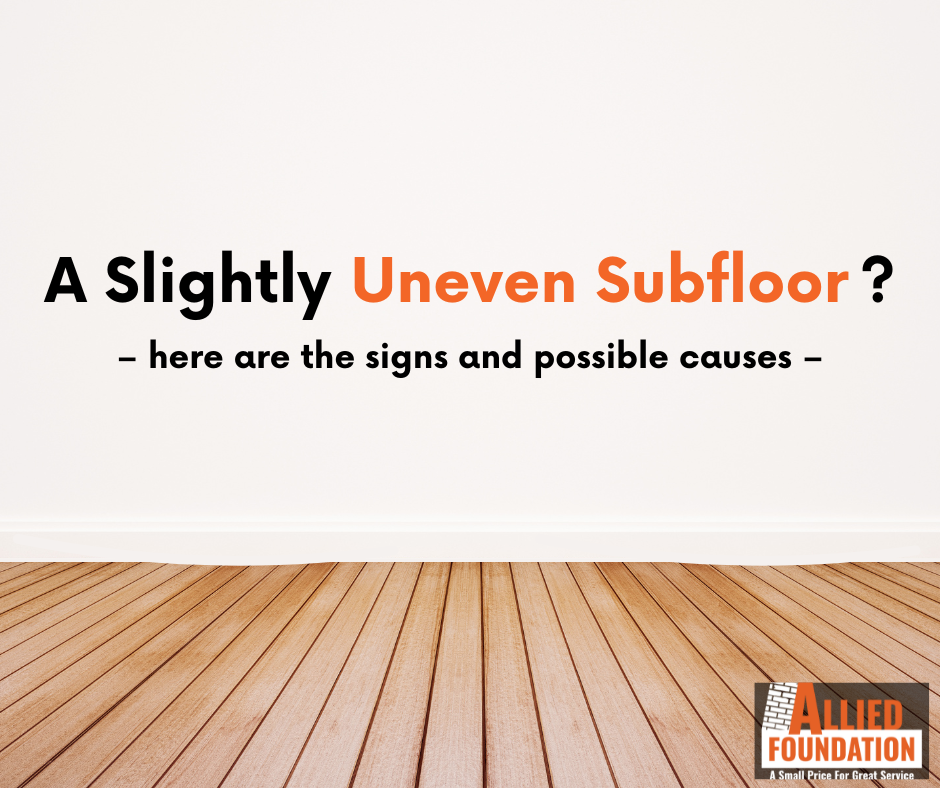When it comes to extensive structural damage in a home, there’s a fundamental truth that most big problems arise from small issues, such as a slightly uneven subfloor. Even though uneven subfloors are common in many Houston homes, they’re also one of the first indicators of foundation damage.
Since identifying foundation problems early can help prevent structural damage in your home, let’s take a look at 2 signs that indicate you have an uneven subfloor even when the floor on top appears to be perfectlyflat and level.
Sign #1: Sloping Floors
When a subfloor is only slightly uneven, it’s difficult to realize something isn’t quite right by simply walking around your home. It is for this reason that you should check your floor’s levelness on a regular basis.
The easiest way to do that is to drop a few marbles onto the floor in different areas. If they roll away, yourfloor is sloping. While doing this, remember that a steeper slope will cause the marbles to roll faster. On the downside, this method may not work well on tile or carpeted floors.
Another way to check your floor for levelness issues is to use an8-foot carpenter’s level. By keeping the level in a perfectly horizontal position—which is indicated by the air bubble located in the center of the level—and measuring the gap between the level and the floor, you can determine the direction of the slope as well as how much your floor is out of plane. A sloping floor almost always indicates an uneven subfloor, which may be caused by one or more issues with the subfloor itself or the foundation underneath.
In the case of a slightly uneven subfloor, the only way to know for sure whether your floor is truly sloping is to have it checked by a professional. An experienced flooring contractor can tell you exactly how close your floor is to its intended slope—which should ideally be zero. For accurate results, professionals compare the change in elevation between 2 points, over a distance of 10 feet, along the entire length and width of the floor.
Sign #2: Sagging or Bumpy Floors
Unless your floor has some serious flatness issues, the only way to find out whether it has any bumps, waves, or sags in certain areas is to measure its flatness. To determine floor flatness, professionals recommend tracking all the differences in elevation between 2 points that are 1 foot apart. You should repeat this procedure for the entire length and width of the floor.
Similar to floor levelness, floor flatness can be checked with the carpenter’s level. However, most professionals prefer to use special devices, like laser levels or 3D laser scanners, which allow them to identify even the smallest flatness and levelness issues in any type of flooring. Accurately measuring the slope of a floor and determining the exact location of any bumps, dips, or waves are important factors in diagnosing subfloor orfoundation issues that may require leveling.
Why Is It Important to Check Your Floor’s Levelness and Flatness?
In short, an uneven subfloor could be the result of multiple underlying issues, including warped floor joists, rotting wood, poor drainage, andexpansive clay soil underneath the foundation. Since an uneven subfloor negatively impacts the floor on top, any flooring issues you observe in your home may indicate the existence of some serious underlying problems that could compromise the structural integrity of your foundation. Regardless of the underlying causes, a weakened foundation will eventually lead to more extensive damage throughout your home, which may manifest itself as cracks in walls and floors, bowed walls, and even ceiling and roof issues.
When Should You Worry?
Regularly checking for any changes in your floor’s flatness and levelness could help you establish whether the problems previously identified are ongoing. If the new measurements show the problems have gotten progressively worse, be sure to contact a foundation repair contractor to have your foundation inspected as soon as possible. Additionally, specialists recommend comparing the current measurements to the Original Construction Elevation (OCE) survey, which is also referred to as the Foundation Elevation survey, if available. Done when a house is built, this survey shows exactly how level and flat the foundation and floor were right after they had been built.
As a general rule, you should worry when:
- Your floor is more than 1 inch out of level over a distance of 20 feet or less;
- Your floor feels unnaturally soft, bouncy, or spongy;
- There are any visible signs of subfloor and/or foundation problems;
- You’ve observed specific issues, like cracks or gaps, in the ground around your foundation;
- You’ve noticed standing water near your foundation or in the crawlspace.
Uneven or unlevel floors can be a frustrating problem for any Houston homeowner. If you’re also experiencing this issue, the only way to restore your floor and foundation to their former glory is bycontacting Allied Foundation today! In addition to providing free foundation inspections and estimates, we also offer a lifetime transferable warranty that covers 100% of any foundation repair work we do.



